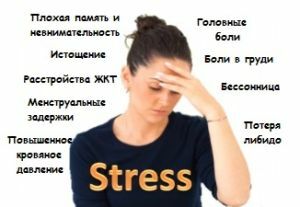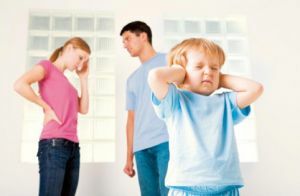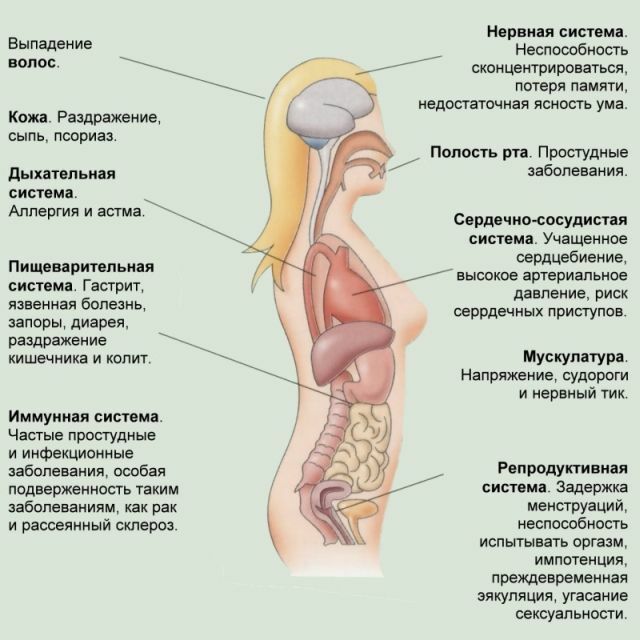 Stress - a set of psychophysical reactions of the body to various types of stimuli. For the first time a concrete concept was introduced by Walter Cannon, in the works on the general universal reaction "Fight or run."
Stress - a set of psychophysical reactions of the body to various types of stimuli. For the first time a concrete concept was introduced by Walter Cannon, in the works on the general universal reaction "Fight or run."
But a complete description of the process, in terms of physiology, brought Hans Selye. Back in the 1920s, he noticed a general nonspecific reaction of patients to various types of stimuli, later, in works on the general adaptive syndrome, Selye described a specific process. Direct linking of the term "stress" to his work was carried out in 1946.
Contents of
- Development stages of
- Importance of timely detection of
- What can be stress?
- The first signs of the disease
- The women are vulnerable. ..
- Men are also not very easy
- Manifestations in children
- Acute form
- Chronic form
- Diagnosis independent and from the
- side View from within
- View from
- Boundary states
Development stages of
If to consider the works of Hans Selye, the development of stress can be divided into three stages:
- Stage of alarm .The organism, reacting to a certain stimulus, starts the process of adaptation.
- The stage of resistance .The period of reaction of an organism to an acting element.
- Depletion stage .The reserve of adaptive energy is gradually drying up.
Initially, the stress reaction was considered exclusively as a negative process, but later a division into:
- Eustress ( the body's response to some positive effects).The specific type is characterized by a positive progression - memory improves, curiosity and efficiency increase.
- Distress ( reaction to negative factors).Often leads to negative reactions that reduce the overall performance.

Importance of timely detection of
Considering a stressful state as a medical problem, one can trace the relationship - the result of nervous overstrain is expressed in inadequate behavior. Gradually, some negative consequences start to appear: uncontrolled emotional states, aggression or excessive quick temper.
If you miss certain signs and symptoms, then the stress reaction can gradually go into different depressive states and, accordingly, more complex and dangerous reactions to a person may appear.
Often, depression leads to a decrease in efficiency and lack of interest in life. It can cause suicidal tendencies. Accordingly, it is necessary to determine in time and avoid such a course of events, timely and adequately reacting to the developing problem.
What can be stress?
The following types of stress are distinguished, according to the impact model:
- Physical stress is a specific reaction of the body to various physical and physiological stimuli. It manifests itself as a reaction to: fatigue, temperature, thirst, pain, hunger. Short-term loads can also have a hardening effect, but the face for each individual.
- Mental( emotional) stress is a primary reaction to emotional stimuli. The concrete type is manifested as a reaction to various unpleasant situations, but sometimes it is a consequence of some far-fetched factors.
- Short-term stress manifests itself as hardening factors. Usually, it is the main psychophysical reaction to an unconventional situation. A particular example of short-term stress, which causes a positive adaptive result, can be considered hardening with cold water.
- Chronic stress - refers to depressing reaction patterns. The body begins to be oppressed in all its manifestations, a decline in immunity and a decrease in the activity of mental functions is possible. As a particular example, one can cite a reaction to the death of a loved one.

The first signs of the disease
Like any disease, stress has its own developmental factors and a certain symptomatology, it is natural that for each person and for each specific situation, the symptoms may vary, as well as the individual perception of the problem.
The general signs of stress include:
- increased irritability and emotional decline;
- permanent insomnia;
- pessimistic mood and indifference;
- memory impairment and concentration;
- decreased or increased appetite;
- headaches and fatigue.
If to take into consideration stressful conditions and the certain signs inherent only to concrete type it is possible to distinguish clearly - man's stress and female which can possess own signs.
Women - beings vulnerable. ..
Women - subtly feeling nature and their spiritual harmony to break quite simply, but to restore peace - a more difficult task.
The solution of the problem begins with its detection, and for female stress the following symptoms are typical:
- destabilization of weight;

- anxiety and irritability;
- insomnia and headaches;
- skin rashes;
- back pain and abnormal digestive tract;
- shortness of breath and high blood pressure;
- reduced concentration of attention;
- disorders of the menstrual cycle and decreased libido.
Men are also not easy
Men are considered to be quite stress-resistant, compared to women, but similar conditions for them are also not uncommon.
Nervous overexertion affects the condition of men no less than on the condition of women. Although the symptoms of stress in men are largely similar to the female variant, but there are some nuances:
- aggressive behavior and irritability;
- erectile dysfunction and decreased sexual desire;
- hypertension and headaches;
- reduced criticality of perception.
Manifestations in children
Not only adults can feel the negative impact of stress factors. Cases of childhood stress are not uncommon, they can have the following symptoms:
- nausea and colic;
- aggressive reactions;
- falseness;
- attention disorder and sleep.
 Usually, such conditions in children are caused by some difficulties in the process of learning and communicating with peers.
Usually, such conditions in children are caused by some difficulties in the process of learning and communicating with peers.
Stressful symptomatology has many points, but if you take some boundary models of stress, then they may differ.
The most difficult conditions are: acute and chronic stress. Each of these models has some nuances of its own manifestation.
Acute form of
In general, it is common to share acute stress and post-traumatic stress. Nevertheless, one can notice some common roots of both variations of the human condition.
Each of the specific types of stress, stands out by what is associated with some situation that led to a deep state. Identifying the symptomatic points of an acute stressful process, you should specify:
- increased anxiety;
- sensations of unreality - both the world around us and our own personality;
- irritability and acute attacks of aggression;
- memory and sleep disorders;
- striving to avoid resembling circumstances and objects.
If we pay attention to the differences in these variations of the acute model of the stress situation, the difference is that post-traumatic stress does not always take place in an acute variant that lasts no more than a month.
Sometimes, the post-traumatic type changes into chronic chronic stress, which has its own exceptional manifestations.
Chronic form
Considering in detail the chronic stress, it can be clearly defined - this is a long process. In fact, this model is marked by the duration and the fact that the next disorder and aggravation of the situation can occur for absolutely insignificant reasons. As symptoms of chronic stress, it is worth mentioning: 
- hypersensitivity;
- fixation on the root cause;
- hypersensitivity to natural irritants( light, sound);
- reduced concentration and activity of thinking;
- prolonged sleep disturbances;
- malfunctions in the autonomic nervous system;
- disorders in reproductive systems.
Diagnosis itself and from
For each of the stressful conditions, it is possible to identify certain signs, symptoms, behavioral nuances, internal sensations.
Such a decline in mental strength can not go unnoticed and it's not so difficult to notice yourself.
View from inside
If you spend some consideration of internal sensations, then you can with a high degree of probability to diagnose your own stress disorder. Often, during a period of stress, a person experiences the following sensations:
- life is permanently losing its colors;
- positive emotions are not actually perceived;
- lack of desire to communicate with others;
- feels a general decline in strength;
- there is no interest in any kind of activity.

View from
There is also an opportunity to notice and the begun stress in their own environment. If you look at a person in a similar state, you can see in him similar symptoms and manifestations of disturbance of mental balance:
- decrease in self-esteem;
- inattention;
- is a strange detachment from reality;
- inadequate response to treatment.
Boundary states of
Unfortunately, stress can be transferred to rather complex forms of mental disorders, and depression is just the tip of the iceberg. People, in a state of neglected stress, can move on to obsessive pathological conditions and neuroses. Usually, these are common ailments and obsessive thoughts of the following categories:
- suicidal desires;Desires of violence;
- loss of composure;
- paralyzes its own position.
All these moments allow us to find out the problem in time, both in ourselves and in our relatives. A clear definition of a stressful condition, in turn, provides an opportunity to avoid its transition to prolonged depression and to other pathologies of the psyche.
Quite often, deep and acute degrees of stress, require urgent medical help, and independent attempts to get rid of it - are doomed to failure.



